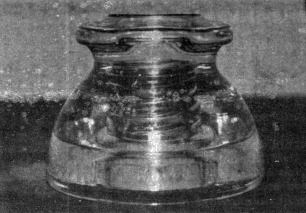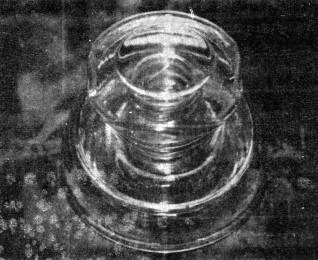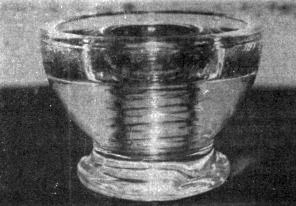Corning Glass Works Insulator Production and the Corning-Pyrex 660
Text by Jeff McCurty, Photographs by Dan Wagner
Reprinted from "INSULATORS - Crown Jewels of the Wire", April 1983, page 11
Corning-Pyrex insulators were
manufactured by the Corning Glass Works in Corning, New York, from 1924 through
1951. Initial consideration to use glass as an insulator material by Corning is
dated as far back as 1913 according to existing records. Pyrex glass was
developed in 1915 by Corning and was used for cookware, bakeware, and
laboratory glass products. Pyrex is a heat-shock resistant borosilicate glass of
80% silica, 4% alkali, 2% alumina, and 13% boric acid. Trademark Pyrex was
registered July 10, 1915, issued July 13, 1917, and patented May 27, 1919,
#1,304,623. Corning used Pyrex glass for all of their production of
communication, power, and radio insulators. The permanent characteristics of the
glass sold under the Pyrex trademark met the insulation requirements for high
voltage transmission.
The records at The Archives in Corning, New York, show
that the Glass Works in 1922 and 1923 proposed insulator development of
suspension type units. A few hundred of these suspension units were installed at
an unspecified location in northern New York State on a trial basis. They were
manufactured at a loss to the Glass works. Also found, of interest, in the
records is the notation that as of early 1923 the labs at Corning did not
propose to spend very much time on the development of pin-type insulators and
would rather put their efforts into the suspension units. It was believed that a
Pyrex insulator could be developed to take the place of two porcelain suspension
units with the same factor of electrical safety. The Pyrex unit would have high
flashover value and puncture value, but not excessive strength.
A couple years
later in 1926 and early 1927 sample pin types were being shipped around the
country to different power and electric companies. These were catalog models
161, 661, 662, 271, 401 and 441. Each company received approximately one half
dozen insulators. Apparently the Glass Works Labs had changed their minds, and
by 1931 these Pyrex pin-types were being sold to power companies throughout the
United States in California, Arizona, Oklahoma, Iowa, Pennsylvania, and New
York. The moulds for catalog models 353, 453, 553, and 663 were authorized
throughout 1931 and samples were scheduled to be ready in 1932. In a 1932 Pyrex
Market Report, the Glass works felt they should be offering not just pin-types
and suspension insulators, but bushings, insulators for interior and exterior
switches, and specialty items.
The main objective of this article is to present
information collected on the Corning-Pyrex #660 insulator from the few existing
records at The Archives in Corning, New York. It is believed the 660 was a test
insulator, and I will backtrack a few years in order to present this
information. To compliment the text, or possibly to verify it, information will
also be presented in the way of Photographs and descriptions of the only
Corning-Pyrex 660 known to exist.
The Corning Glass Works received an order from
American Telephone and Telegraph Company in January 1924 for 150 each of two
types of insulators designed for pole line carrier current systems. The mould
body was to be the same, while the pin design would differ in that one would use
wood pins while the other would use metal pins of the so called "British
P.O." type. The external mould for the 300 units was to be shipped by the
Western Electric Company. The purpose of this test was to determine the
respective values of the pin designs when using Pyrex glass insulators. The
shape selected was a standard insulator for use with wood pins. A new design of
insulator was under consideration using a metal pin.
Sample Pyrex insulators
made from a #660 power insulator of 702 E.J. glass were furnished A.T.&T.
Co. for tests in the spring of 1924. They were installed on a trial line in
Phoenixville, Pennsylvania, and were favorably received with no problems
resulting. The line reportedly gave much better results at 30,000 cycles
(carrier current frequency) than standard Hemingray glass insulators. It was
anticipated that a line of 5,000 to 10,000 units would be employed during 1925
and possibly 1926, but heavy winter storms advanced this proposal. into the
future. American Telephone and Telegraph Company also proposed to install a
section of the New York-Baltimore-Richmond circuit in early 1925 with two trial
lines each using 17,500 insulators. One would be using wood pins, while the
other would use metal pins.
Corning Glass Works had the job of delivering 35,000
insulators in early 1925. The insulator design would preferably be a
modification of the Western Electric mould as covered by the original order for
300 units. It is noted that a supply of specially manufactured insulators
similarly shaped to the 660 in 720 B.E. glass was delivered and tested in
January, 1925. The losses were one-half or equal to the 702 E.J. unit.
The only
other information on record is as follows. A decision was made to install more
insulators on a service line and to make them of a specific design. The test
results of the 660 insulator encouraged the Long Island Department of
A.T.&T. Co. to increase their trial quantity up to 180,000. The lines were
designed for the 720 B.E. glass insulators, and new test results left no margin
of safety. A decision was reached for Corning Glass Works to manufacture 90,000
insulators for the Long Island Department of this new type of insulator. It was
expected that from the design angle, the test results would be secured to equal
the Pyrex 660 type insulators.
Some speculation was used in the writing of this
article, because much of the information on record is in the form of proposals
with vague dates and time references given. All in all, there is not that much
information to go on. American Telephone and Telegraph Archives have no record
of purchasing 300 test insulators from Corning Glass Works, and the proposed
test line of 5,000 to 10,000 insulators in 1925 is unsubstantiated, with no
records of it being carried out.
However, I believe that the Pyrex 660 insulator
was produced of 702 E.J. glass for the original order of the 300 test insulators
for A.T.&T. Co. and at the completion of this test period, the experimental
site and these insulators were taken down. Subsequent test sites were then
furnished with the modified 660 insulator, possibly the future 661 or 662 in
sample quantities. Because in different tests, losses proved to be one-half or
equal, this new insulator became the model for actual production and was most
likely used on the New York-Baltimore-Richmond line. The 661 was first
manufactured for sale in June, 1926. The 662 was first manufactured in May,
1926. The first shipment of large orders for both insulators was in July, 1926.
The one indisputable fact is that there is a Pyrex 660 insulator in existence.
The insulator is 3" tall, 3-7/8" wide at the base, 2-3/4" across
crown top, and 2-1/2" where the sides are flat. The very top of the 660 is
1-1/2" in diameter. The coloring is an extremely light yellow/clear. Please
refer to the photographs.



The mould markings are F: 660-PYREX PAT. MAY-27-1919.
B: CORNING MADE IN U.S.A. It is the only example of a Corning-Pyrex insulator
with a flat, round top, while all others of the pin-types have either a dome or
saddle groove top.
It is possible this flat, round top proved to be
inappropriate for prolonged line usage, or it was never meant to be used for
prolonged periods of time. It is also possible that rain water did not easily
flow off the flat surface and created problems in this respect. The date is in
reference to the Pyrex Glass patent, and the only other insulator so dated is
the Pyrex Stacker composed of one CD 248 and two CD 311's. Corning has no
information or known reason as to why the date was included in the marking.
I
feel it is very possible the Pyrex Stacker was also a test insulator of some
kind, because as far as I know it does not appear for sale in any of Corning's
insulator pamphlets. However, this Stacker does appear in a photograph in a
sales pamphlet for power line insulators as being in use by the Montana Power
Company from 1924 through 1926 operating at 50,000 to 60,000 volts service. The
Pyrex 441 insulator was introduced in early May of 1926 for 50,000 volt service
and was possibly the design derived from the Stacker's test results. Again, I am
using some speculation.
As a note of interest, the Pyrex 441 insulator in
February 1927 was selling for $2.00. There is a notation in a letter dated
March, 1927, that because the 441 is not the best possible design, it may have
to be replaced with a 50 KV unit closely following our latest developments in
insulator design. I feel it is clear enough even without numerous records, that
Corning was constantly testing and updating their insulators to meet new demands
and markets.
As stated earlier, the 660 insulator as presented in this article
is the only one known to exist. I feel it is one example of a great amount of
time and research spent to improve the quality of glass insulators, and may be
the prototype of many of the other Pyrex series insulators that were
manufactured in the late 1920's through the 1940's. There have been rumors of
another 660 in a private collection someplace. If anyone knows of this insulator
or any other 660's, would you please send it, or at least photographs of it, to
Dan Wagner or myself for confirmation. I realize it is possible there are whole
lines of 660's out there someplace, or that they are buried in a long forgotten
dump. The original source of the insulator presented here is unknown. Until one
or more of these come to light, the 660 as presented here remains a most unique
insulator.
|
